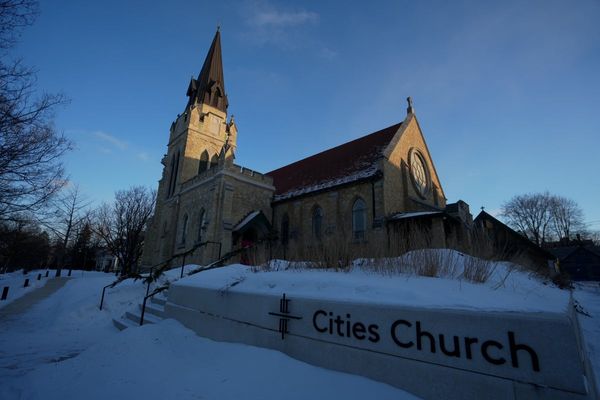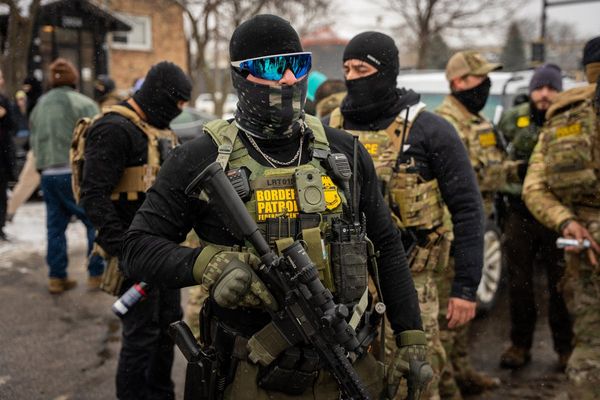
When Paris’s art curators met to discuss staging a major retrospective of Ukrainian photographer Boris Mikhailov’s work, none could have guessed how prescient and tragic its eventual timing would turn out to be – or how his depictions of the poverty of the Soviet Union and the grim hardship of its aftermath would take on new meaning following Russia’s invasion of Ukraine and the razing of his home town, Kharkiv, which features in so many of his photographs.

Mikhailov’s blue-tinted series of 111 pictures taken in newly independent Ukraine’s second largest city after the collapse of the USSR in 1991, titled At Dusk, are bleak. There is little evidence of the much-vaunted grandeur of the Soviet Union as proudly declaimed by various leaders in Moscow. The system had changed, but the penury and hardship of people’s lives had not, as shown by the stark images of men, women and children captured in the detritus of a desolate urban landscape.
Kharkiv briefly emerged from this to become a thriving, cosmopolitan metropolis, though Mikhailov’s photos from the first decade of the 21st century show independence and capitalism had brought colourful advertisements and billboards, but also an ocean of cheap plastic goods and plastic bags. Then Russia invaded Ukraine in February this year.
“I would say it is almost certain that most if not all of the buildings and places in the photographs no longer exist,” says Laurie Hurwitz, curator of a major retrospective of Mikhailov’s work at the Maison Européenne de la Photographie (MEP) in Paris. “It brings a tear to the eye to know that they have been bombed and destroyed.
“It’s difficult to believe what Mikhailov lived through before. This exhibition is hard and beautiful and still gives me the shivers even thought I walk through it every day.”
One photograph called The Theatre of War, Second Act, Time Out, taken in 2013, shows a scene from Kyiv’s Maidan square as Ukrainian protesters pitched their tents.

“Boris is very relevant now in every way … He won’t say what he thinks of Putin. He doesn’t talk about what is going on now in Kharkiv but it clearly affects him. The roots of the war can been seen in his work,” Hurwitz said.
Born in 1938 in Kharkiv, Mikhailov trained as an engineer and taught himself photography; his early work was radical and subversive. He was a member of the dissident collective Vremya, which later became the Kharkiv School of Photography, which profited from a slight liberalisation of life known as “Khruschev’s thaw” – after the then Soviet leader Nikita Khrushchev who succeeded Joseph Stalin – to reject the ideology of “Soviet realism”.

Early in his engineering career, Mikhailov was given a camera and instructed to document work at the state-owned factory where he was employed. He used it to take nude photographs of his wife, Vita. He developed them secretly in the factory’s laboratory but was fired after they were discovered by the Soviet authorities. Afterwards he eked out a living as a commercial photographer and would later use copies of photos people sent to him to be enlarged or improved to create works of art, using kitsch colours. In one, his own passport photo, Mikhailov is shown in his green serge Soviet military uniform; he has decorated the jacket with Ukrainian embroidery and painted his lips red.
The Salt Lake series of 1986, sepia-coloured photographs taken secretly, show Soviets enjoying their “freedom” at a popular bathing spot in the Donbas region of southern Ukraine. The bathers believed the warm salty water had curative properties; in fact it was a heavily polluted and poisoned industrial site surrounded by factories.

The Red series, taken between 1965 and 1978, consists of 84 colour photographs taken in Kharkiv containing the colour red, a symbol of the revolution and Soviet empire. At Dusk is a series of panoramic photographs of Kharkiv in the north-east of Ukraine, tinted in blue, a colour that Mikhailov said reminded him of the second world war: “Blue for me is the colour of the blockade, hunger and war.”
The exhibition also features a number of photographs of Mikhailov, his wife, and others posing nude, which led to the Soviet authorities describing his work as “pornographic”.

He was regularly tailed by KGB agents, his camera leading to suspicions that he was a western spy.
Before the Covid pandemic, Mikhailov divided his time between Kharkiv and Berlin, where he now lives permanently. He has represented Ukraine at the Venice Biennale in 2007 and 2017, been exhibited at the Tate Modern, MoMA in New York, in Germany and in Kyiv.
The MEP exhibition, postponed from 2020 because of Covid, features 800 Mikhailov works – the catalogue is 2 inches thick – including projected images spanning six decades from the 1960s to 2019.
A short walk across Paris, Mikhailov is also being celebrated at Paris’s Bourse de Commerce, where the Pinault Collection is featuring a display of At Dusk photographs as a supporting act to a Albanian contemporary artist Anri Sala, whose 2011 short film, 1395 Days without Red, throws the spotlight on another war, the conflict in Bosnia and the long siege of Sarajevo.
Simon Baker, MEP director and a former curator at the Tate Modern, writes: “Mikhailov remains one of the greatest and most celebrated photographic artists of his generation … working equally between documentary, performative and conceptual practices. Mikhailov’s ‘diaries’ of life in Ukraine both before and after the fall of the Soviet regime remind us of the rich history and endless resilience of the Ukrainian people.”
• Boris Mikhailov: Ukrainian Diary is at the Maison Européenne de la Photographie until 15 January 2023. At Dusk is at the Bourse de Commerce until 15 January 2023.







